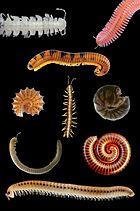毛馬陸目
外觀
| 毛馬陸目 | |
|---|---|

| |
| Polyxenus lagurus | |
| 科學分類 | |
| 界: | 動物界 Animalia |
| 門: | 節肢動物門 Arthropoda |
| 亞門: | 多足亞門 Myriapoda |
| 綱: | 倍足綱 Diplopoda |
| 亞綱: | 毛尾馬陸亞綱 Penicillata Latrielle, 1831 |
| 目: | 毛馬陸目 Polyxenida Verhoeff, 1934 |
| 科 | |
| 異名 | |
|
亞目 | |
毛馬陸目(學名:Polyxenida)為倍足綱下的一個目,最大的特徵在於在柔軟無鈣化的外殼上佈滿了剛毛。毛馬陸目下共有4科至少167種,也是毛尾馬陸亞綱下唯一的現存目。
描述
[編輯]毛馬陸與其他馬陸最大的差異在於牠們具有柔軟無鈣化的外骨骼、甲殼上佈滿了剛毛、較少的腳數量(不超過17對)、且雄性缺乏生殖肢。體型偏小,體長最長不會超過7毫米(0.28英寸)。
防禦機制
[編輯]毛馬陸缺乏一般馬陸所具有的堅硬外骨骼與化學防禦機制[1],而是具有一套獨特的自我防衛方法:牠們身上具倒刺的綱毛十分容易脫落,能殘留在掠食性昆蟲的附肢與口器上,進而阻礙牠們的行動[2]。
繁殖
[編輯]雄性毛馬陸缺乏一般馬陸用來傳輸精子的生殖肢,因此牠們只能透過間接的方式提供精子。雄性會丟下精包,並交由雌性拾取[3]。
許多種的毛馬陸也能進行單性生殖,當雄性個體稀少時,雌性依然有能力在未受精的情況下產卵並孵化下一代[4]。
分類學
[編輯]
毛馬陸為毛尾馬陸亞綱現存的唯一目,且為所有馬陸所屬亞綱的基群。毛尾馬陸亞綱為所有現存馬陸的姊妹群,包括五帶馬陸下綱及蠕形馬陸下綱[6][7]。
2003年,毛馬陸目包含了159種有效種及亞種[8],但是自2010年以來,已陸續發表了至少8個新種[5][9][10]。
- 毛馬陸總科 Polyxenoidea Lucas, 1840
- Hypogexenidae Schubart, 1947
- Lophoproctidae Silvestri, 1897
- 毛馬陸科 Polyxenidae Lucas, 1840
- 合馬陸總科 Synxenoidea Silvestri, 1923
- 合馬陸科 Synxenidae Silvestri, 1923
化石紀錄
[編輯]最早的毛馬陸化石發現於黎巴嫩白堊紀早期的一個琥珀之中[11]。
部分科學家將已滅絕的節肋目與Eoarthropleurida併入毛尾馬陸亞綱之下,作為毛馬陸目的姊妹群[12][13]。
參考文獻
[編輯]- ^ Shelley, Rowland M. The Myriapoda (Millipedes, Centipedes) Featuring the North American Fauna. [12 October 2013]. (原始內容存檔於2019-08-14).
- ^ Eisner, T; Eisner, M; Deyrup, M. Millipede defense: use of detachable bristles to entangle ants. Proceedings of the National Academy of Sciences of the United States of America. 1996, 93 (20): 10848–51. Bibcode:1996PNAS...9310848E. PMC 38244
 . PMID 8855269. doi:10.1073/pnas.93.20.10848.
. PMID 8855269. doi:10.1073/pnas.93.20.10848.
- ^ Shelley, Rowland M. Centipedes and Millipedes with Emphasis on North American Fauna. The Kansas School Naturalist. 1999, 45 (3): 1–16 [2020-02-10]. (原始內容存檔於2016-11-12).
- ^ Barnes, Robert D. 15. The myriapods. Invertebrate zoology 5th. Philadelphia: Saunders College Pub. 1987: 674–683.
- ^ 5.0 5.1 Nguyen Duy - Jacquemin, Monique; Uys, Charmaine; Geoffroy, Jean-Jacques. Two remarkable new species of Penicillata (Diplopoda, Polyxenida) from Table Mountain National Park (Cape Town, South Africa). ZooKeys. 2011, (156): 85–103. PMC 3253573
 . PMID 22303097. doi:10.3897/zookeys.156.2211.
. PMID 22303097. doi:10.3897/zookeys.156.2211.
- ^ Sierwald, Petra; Bond, Jason E. Current Status of the Myriapod Class Diplopoda (Millipedes): Taxonomic Diversity and Phylogeny. Annual Review of Entomology. 2007, 52 (1): 401–420. PMID 17163800. doi:10.1146/annurev.ento.52.111805.090210.
- ^ Shear, W. Class Diplopoda de Blainville in Gervais, 1844. In: Zhang, Z.-Q.(ed.) Animal biodiversity : an outline of higher-level classification and survey of taxonomic richness (PDF). Zootaxa. 2011, 3148: 159–164 [2020-02-10]. doi:10.11646/zootaxa.3148.1.32. (原始內容存檔 (PDF)於2019-07-25).
- ^ Nguyen Duy-Jacquemin, M.; J.-J. Geoffroy. A revised comprehensive checklist, relational database, and taxonomic system of reference for the bristly millipedes of the world (Diplopoda, Polyxenida). African Invertebrates. 2003, 44 (1): 89–101 [2020-02-10]. (原始內容存檔於2016-12-23).
- ^ Short, Megan; Huynh, Cuong. The genus Unixenus Jones, 1944 (Diplopoda, Penicillata, Polyxenida) in Australia. ZooKeys. 2011, (156): 105–122 [2020-02-10]. PMC 3253574
 . PMID 22303098. doi:10.3897/zookeys.156.2168. (原始內容存檔於2014-07-20).
. PMID 22303098. doi:10.3897/zookeys.156.2168. (原始內容存檔於2014-07-20).
- ^ Short, Megan; Huynh, Cuong. Four new species of Unixenus Jones, 1944 (Diplopoda, Penicillata, Polyxenida) from Australia. ZooKeys. 2013, (278): 75–90 [2020-02-10]. PMC 3677348
 . PMID 23794829. doi:10.3897/zookeys.278.4765. (原始內容存檔於2016-03-04).
. PMID 23794829. doi:10.3897/zookeys.278.4765. (原始內容存檔於2016-03-04).
- ^ Duy-Jacquemin, MN; Azar, D. The oldest records of Polyxenida (Myriapoda, Diplopoda): New discoveries from the Cretaceous ambers of Lebanon and France. Geodiversitas. 2004, 26 (4): 631–641.
- ^ Shear, William A.; Edgecombe, Gregory D. The geological record and phylogeny of the Myriapoda. Arthropod Structure & Development. 2010, 39 (2–3): 174–190. PMID 19944188. doi:10.1016/j.asd.2009.11.002.
- ^ Kraus, O; C. Brauckman. Fossil giants and surviving dwarfs. Arthropleurida and Pselaphognatha (Ateolocerata, Diplopoda): characters, phylogenetic relationships and construction. Verh. Naturwiss. Ver. Hamburg. 2003, 40 (5): 5–50.



